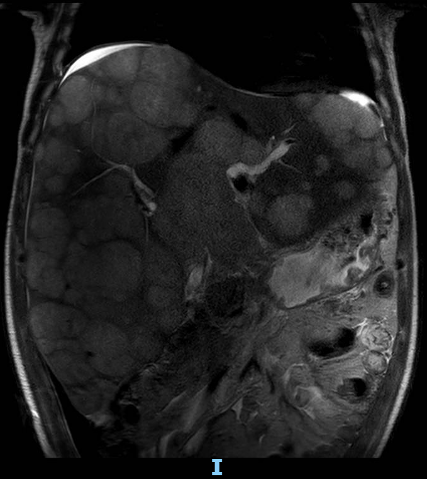Monday Poster Session
Category: Liver
P3843 - A Rare EBV-Associated Adenocarcinoma With Metastasis to the Liver
Monday, October 27, 2025
10:30 AM - 4:00 PM PDT
Location: Exhibit Hall

Yash V. Bhagat, MD (he/him/his)
NewYork-Presbyterian / Brooklyn Methodist Hospital
Brooklyn, NY
Presenting Author(s)
Yash Bhagat, MD, Gres Karim, MD, Neil Mehta, MD, Ilan Weisberg, MD
NewYork-Presbyterian / Brooklyn Methodist Hospital, Brooklyn, NY
Introduction: Ebstein-barr virus (EBV), a herpesvirus that lays latent in B lymphocytes, is associated with several cancers - commonly, Burkitt lymphoma and nasopharyngeal carcinoma. However, 8.8% of the time, it is associated with gastric adenocarcinoma. We present a case of a young man who presented with B symptoms and was found to have multiple liver masses biopsied to be EBV adenocarcinoma potentially of gastric origin.
Case Description/
Methods: A 41 year old Ghanaian man with no past medical history presented with complaints of generalized weakness, fatigue, nausea, and weight loss of 30 kgs over the last 3 months. Physical exam was notable for temporal wasting and hepatosplenomegaly. Computed tomography of the chest, abdomen and pelvis revealed abdominal lymphadenopathy and innumerable hepatic masses. Magnetic resonance imaging of the neck demonstrated no evidence of neck mass or cervical lymphadenopathy. Lymphoma was ruled out on peripheral blood flow cytometry and peripheral blood smear. Additional laboratory testing found high CA-19-9 (155 U/mL) and CEA (9.3 ng/mL), but normal AFP (4 ng/mL). An advanced liver magnetic resonance imaging showed numerous bilobal confluent liver metastases with bulky upper retroperitoneal lymphadenopathy and mild intrahepatic biliary duct dilation. An ultrasound guided biopsy of a mass on the right hepatic lobe resulted in definitive identification of EBV-associated adenocarcinoma positive for AE1/AE3 and EBER protein markers. Serum testing for nuclear IgG EBV antibodies were also found to be high (185 U/mL) further supporting the diagnosis of EBV adenocarcinoma.
Discussion: EBV adenocarcinomas, a rare form of EBV associated malignancy, has been previously shown to affect the gastric pouch and bile ducts. Our case of EBV-associated malignancy underscores the success of EBV at infecting billions of individuals worldwide and raises questions on the predispositions that cause a portion of these infected individuals to develop malignancy. Additionally, while therapeutic treatments of EBV endothelial malignancies have been theorized, no guideline on screening infected individuals has been recommended. Further investigation of the predispositions that cause malignant transformation in EBV infected individuals may help yield a robust framework for preventative care.

Figure: Figure 1: Advanced liver magnetic resonance imaging with contrast demonstrating hepatomegaly with numerous bilobal confluent liver metastases and mild intrahepatic biliary duct dilation.
Disclosures:
Yash Bhagat indicated no relevant financial relationships.
Gres Karim indicated no relevant financial relationships.
Neil Mehta indicated no relevant financial relationships.
Ilan Weisberg indicated no relevant financial relationships.
Yash Bhagat, MD, Gres Karim, MD, Neil Mehta, MD, Ilan Weisberg, MD. P3843 - A Rare EBV-Associated Adenocarcinoma With Metastasis to the Liver, ACG 2025 Annual Scientific Meeting Abstracts. Phoenix, AZ: American College of Gastroenterology.
NewYork-Presbyterian / Brooklyn Methodist Hospital, Brooklyn, NY
Introduction: Ebstein-barr virus (EBV), a herpesvirus that lays latent in B lymphocytes, is associated with several cancers - commonly, Burkitt lymphoma and nasopharyngeal carcinoma. However, 8.8% of the time, it is associated with gastric adenocarcinoma. We present a case of a young man who presented with B symptoms and was found to have multiple liver masses biopsied to be EBV adenocarcinoma potentially of gastric origin.
Case Description/
Methods: A 41 year old Ghanaian man with no past medical history presented with complaints of generalized weakness, fatigue, nausea, and weight loss of 30 kgs over the last 3 months. Physical exam was notable for temporal wasting and hepatosplenomegaly. Computed tomography of the chest, abdomen and pelvis revealed abdominal lymphadenopathy and innumerable hepatic masses. Magnetic resonance imaging of the neck demonstrated no evidence of neck mass or cervical lymphadenopathy. Lymphoma was ruled out on peripheral blood flow cytometry and peripheral blood smear. Additional laboratory testing found high CA-19-9 (155 U/mL) and CEA (9.3 ng/mL), but normal AFP (4 ng/mL). An advanced liver magnetic resonance imaging showed numerous bilobal confluent liver metastases with bulky upper retroperitoneal lymphadenopathy and mild intrahepatic biliary duct dilation. An ultrasound guided biopsy of a mass on the right hepatic lobe resulted in definitive identification of EBV-associated adenocarcinoma positive for AE1/AE3 and EBER protein markers. Serum testing for nuclear IgG EBV antibodies were also found to be high (185 U/mL) further supporting the diagnosis of EBV adenocarcinoma.
Discussion: EBV adenocarcinomas, a rare form of EBV associated malignancy, has been previously shown to affect the gastric pouch and bile ducts. Our case of EBV-associated malignancy underscores the success of EBV at infecting billions of individuals worldwide and raises questions on the predispositions that cause a portion of these infected individuals to develop malignancy. Additionally, while therapeutic treatments of EBV endothelial malignancies have been theorized, no guideline on screening infected individuals has been recommended. Further investigation of the predispositions that cause malignant transformation in EBV infected individuals may help yield a robust framework for preventative care.

Figure: Figure 1: Advanced liver magnetic resonance imaging with contrast demonstrating hepatomegaly with numerous bilobal confluent liver metastases and mild intrahepatic biliary duct dilation.
Disclosures:
Yash Bhagat indicated no relevant financial relationships.
Gres Karim indicated no relevant financial relationships.
Neil Mehta indicated no relevant financial relationships.
Ilan Weisberg indicated no relevant financial relationships.
Yash Bhagat, MD, Gres Karim, MD, Neil Mehta, MD, Ilan Weisberg, MD. P3843 - A Rare EBV-Associated Adenocarcinoma With Metastasis to the Liver, ACG 2025 Annual Scientific Meeting Abstracts. Phoenix, AZ: American College of Gastroenterology.
